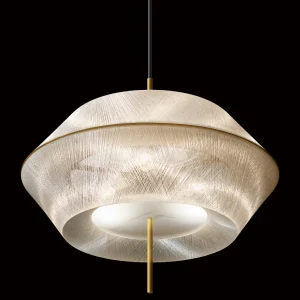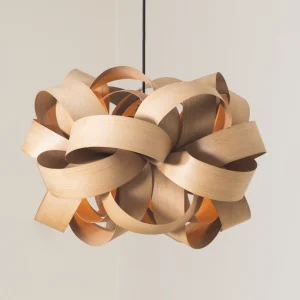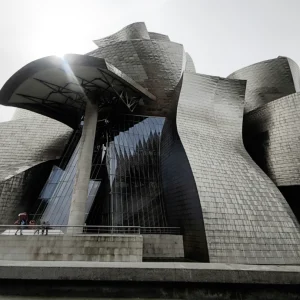Words By Emily Martin
PROJECT INFO
Client Bristol City Council for Bristol Music Trust
Architect Levitt Bernstein www.levittbernstein.co.uk
Interior designer Levitt Bernstein
Acoustician Sound Space Vision
Theatre consultant Charcoalblue
Structural engineer Arup
Size 8,362m2
ARCHITECTURE STUDIO Levitt Bernstein has completed a highly anticipated reimagining of Bristol Beacon for Bristol City Council and Bristol Music Trust. This transformational project has created a centre of excellence for music of all kinds, where it can be created, performed, recorded and broadcast, all under one roof.
 New timber-lined balconies, shaped to optimise room acoustics, with trifurcating steel columns to support the upper balconies and technical decks, deliver a dramatic visual signature that combines heritage with world-leading acoustics and 21st-century tech; the former bonded cellars beneath Beacon Hall have been converted into a suite of creative spaces for music education, practice rooms, library, recording studio, digital music lab and a new cellar venue for smaller, more intimate concerts and emerging artists. Image credit: Tim Crocker
New timber-lined balconies, shaped to optimise room acoustics, with trifurcating steel columns to support the upper balconies and technical decks, deliver a dramatic visual signature that combines heritage with world-leading acoustics and 21st-century tech; the former bonded cellars beneath Beacon Hall have been converted into a suite of creative spaces for music education, practice rooms, library, recording studio, digital music lab and a new cellar venue for smaller, more intimate concerts and emerging artists. Image credit: Tim Crocker
This completion follows Levitt Bernstein’s new foyer building in 2009, and it is the second and final phase of a project that promotes Bristol Beacon as an exemplar of international quality within the music industry. Levitt Bernstein has repaired, restored and upgraded the original fabric of the Grade II listed building, conserving the distinctive Victorian architecture while reimagining its future. The architectural works celebrate the highly significant Bristol Byzantine style of the original building while adapting it for today’s audiences and modern venue operation.
 New timber-lined balconies, shaped to optimise room acoustics, with trifurcating steel columns to support the upper balconies and technical decks, deliver a dramatic visual signature that combines heritage with world-leading acoustics and 21st-century tech; the former bonded cellars beneath Beacon Hall have been converted into a suite of creative spaces for music education, practice rooms, library, recording studio, digital music lab and a new cellar venue for smaller, more intimate concerts and emerging artists. Image credit: Tim Crocker
New timber-lined balconies, shaped to optimise room acoustics, with trifurcating steel columns to support the upper balconies and technical decks, deliver a dramatic visual signature that combines heritage with world-leading acoustics and 21st-century tech; the former bonded cellars beneath Beacon Hall have been converted into a suite of creative spaces for music education, practice rooms, library, recording studio, digital music lab and a new cellar venue for smaller, more intimate concerts and emerging artists. Image credit: Tim Crocker
The project’s programmatic needs were extensive, including: the renewal of existing music performance halls and backstage areas; the remodelling of secondary spaces, such as the underused cellars, to introduce new music education studios and club-style third venue; and the insertion of new AV, stage engineering and upgraded building services. Additionally, a new restaurant has been incorporated within the historic colonnade, complementing the venues with a characterful dining space for visitors and audiences to enjoy.
 New timber-lined balconies, shaped to optimise room acoustics, with trifurcating steel columns to support the upper balconies and technical decks, deliver a dramatic visual signature that combines heritage with world-leading acoustics and 21st-century tech; the former bonded cellars beneath Beacon Hall have been converted into a suite of creative spaces for music education, practice rooms, library, recording studio, digital music lab and a new cellar venue for smaller, more intimate concerts and emerging artists. Image credit: Tim Crocker
New timber-lined balconies, shaped to optimise room acoustics, with trifurcating steel columns to support the upper balconies and technical decks, deliver a dramatic visual signature that combines heritage with world-leading acoustics and 21st-century tech; the former bonded cellars beneath Beacon Hall have been converted into a suite of creative spaces for music education, practice rooms, library, recording studio, digital music lab and a new cellar venue for smaller, more intimate concerts and emerging artists. Image credit: Tim Crocker
Mark Lewis, associate director at Levitt Bernstein, comments: ‘From the outset, it was important that this project was about more than a concert hall. It is a resource for the people of Bristol and, with the support of the council and the Music Trust, our work means this venue can bring classical and contemporary culture and innovation to the city.’
 New timber-lined balconies, shaped to optimise room acoustics, with trifurcating steel columns to support the upper balconies and technical decks, deliver a dramatic visual signature that combines heritage with world-leading acoustics and 21st-century tech; the former bonded cellars beneath Beacon Hall have been converted into a suite of creative spaces for music education, practice rooms, library, recording studio, digital music lab and a new cellar venue for smaller, more intimate concerts and emerging artists. Image credit: Tim Crocker
New timber-lined balconies, shaped to optimise room acoustics, with trifurcating steel columns to support the upper balconies and technical decks, deliver a dramatic visual signature that combines heritage with world-leading acoustics and 21st-century tech; the former bonded cellars beneath Beacon Hall have been converted into a suite of creative spaces for music education, practice rooms, library, recording studio, digital music lab and a new cellar venue for smaller, more intimate concerts and emerging artists. Image credit: Tim Crocker
Bristol Beacon encompasses three main performance halls. Beacon Hall – a professional concert hall with capacity for around 1,800 – is a first-class, industry-leading facility. Designed as a contemporary intervention, Levitt Bernstein has built a new flexible and adaptable interior within the 1867 original masonry walls. New timber-lined balconies, shaped to optimise room acoustics, with trifurcating steel columns to support the upper balconies and technical decks deliver a unique and dramatic visual signature that combines heritage with worldleading acoustics and 21st-century technology.
 The Lantern Hall is designed for more intimate concerts, new work, spoken word and other events. Image credit: Shotaway
The Lantern Hall is designed for more intimate concerts, new work, spoken word and other events. Image credit: Shotaway
‘We have been careful to retain the historic character of the building, working sensitively within the constraints of the exiting fabric, to create a space which is both respectful to its heritage and environmentally sustainable, while bringing the halls within up to standards that can compete with venues on an international stage,’ comments Lewis. ‘This transformation will mean that Bristol Beacon can continue to be enjoyed, loved and, most importantly, well-used by everyone, for generations to come.’
The new interior has been nested into the building’s Victorian shell. Taking cues from the original pilasters and arched window openings, the design references the visual memory of the historic architecture within the new interior. The adaptability of the new interior, through variable acoustics, removable seating and access for lighting, makes it one of the most flexible and accessible concert halls in the country.
The second, or Lantern Hall, has been much altered during the building’s history, having been converted to a theatre, bar, and ad hoc second venue since 2009. Levitt Bernstein has completed external restoration works that reinstate the original architectural composition of the Colston Street façade by removing later additions, reopening the colonnade to its original width of seven bays and reopening the windows to the Lantern Hall. At ground level, the former box-office space is now better purposed as a public restaurant and cocktail bar, which creates an activated ‘shop front’ with a new screen of frameless glazing positioned behind the stone columns. The full size of the original daylit atrium has been reinstated and features a new modern staircase contrasting with the Victorian architecture. The Lantern Hall sits alongside this space and is now a high-quality second performance venue for all kinds of music. With a smaller capacity of around 300 to 500 (standing), this space is designed for more intimate concerts, new work, spoken word and other events.
The atmospheric former bonded cellars beneath Beacon Hall have been carefully converted into a suite of creative spaces for music education, practice rooms, library, recording studio, digital music lab and a new cellar venue for smaller, more intimate concerts and emerging artists. This third hall is an additional performance space or cabaretstyle club venue for 100-250 people that can also be used for rehearsal, education or breakout space.
 The atrium features a new modern staircase contrasting with the Victorian architecture, while a new restaurant has been incorporated within the historic colonnade. Image credit: Shotaway
The atrium features a new modern staircase contrasting with the Victorian architecture, while a new restaurant has been incorporated within the historic colonnade. Image credit: Shotaway
Public art curator Field Arts Projects worked closely with Levitt Bernstein to ensure Bristol Beacon is rejuvenated with artists’ voices at its heart. Linda Brothwell, Libita Sibungu, Rana Begum and Giles Round, among others, have each created a bespoke work to enhance the look and feel of the venue, adding to the richness of the transformation and the experience for visitors.
With a focus on acoustic excellence, sustainability and heritage, Bristol Beacon required a bold and imaginative strategy to ensure it would excel in use. The Beacon Hall offers near-perfect acoustical conditions for the enjoyment of both amplified and non-amplified sound for audiences and musicians. To achieve this, Levitt Bernstein collaborated with worldrenowned acousticians Sound Space Vision to implement a creative design that delivers excellent acoustic conditions in each space.
 The atrium features a new modern staircase contrasting with the Victorian architecture, while a new restaurant has been incorporated within the historic colonnade. Image Credit: Tim Crocker
The atrium features a new modern staircase contrasting with the Victorian architecture, while a new restaurant has been incorporated within the historic colonnade. Image Credit: Tim Crocker
‘One of the most challenging aspects was to ensure that the venue is able to deliver excellent acoustics for all kinds of music across the three new auditoriums, placing Bristol Beacon on the map as competing with its European counterparts,’ explains Lewis. ‘This did not only apply to the interior design but also the implementation and running of the building’s services within the historic shell in a sensitive manner. Ventilation must be silent, requiring large ducts and outlets to be concealed within the constrained dimensions of the historic building. Different solutions were developed for each auditorium. In Beacon Hall, ventilation is provided from beneath the seats. In the Lantern Hall, it is ducted through the reinstated decorative corner pilasters and behind the seating. In the cellar venue, trenches were excavated below the floor to preserve the ceiling height and historic vaulted ceiling. Acoustical requirements were also a primary consideration for interior architecture. In the Beacon Hall every surface has been selected, shaped and finished to optimise acoustical performance.’
KEY SUPPLIERS
Lighting
Zumtobel www.zumtobel.com
Surfaces
Domus www.domusgroup.com
Surfaces
Ege Carpets www.egecarpets.com
Forbo www.forbo.com
Interface www.interface.com
Bolon www.bolon.com





